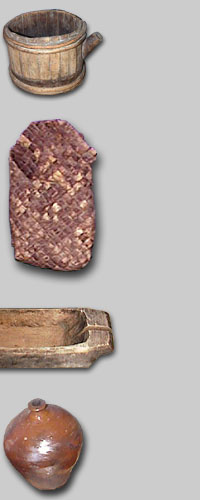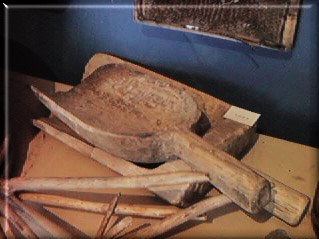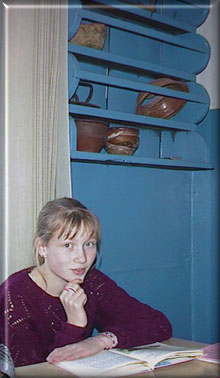

 Additionally many things were donated by village population, who have heard about our efforts to
found a museum and supported this idea. Some of the donators had to make a long trip up to our
school while bringing their gifts. I'll never forget an elder man, native to the small village of Hubjala,
shyly sitting in the corner of the school hall waiting classes to end not daring to ask not to disturb. With a heavy burden of museum items
he had to cross two big lakes walking meanwhile a narrow forest path in order to reach our bigger settlement.
Additionally many things were donated by village population, who have heard about our efforts to
found a museum and supported this idea. Some of the donators had to make a long trip up to our
school while bringing their gifts. I'll never forget an elder man, native to the small village of Hubjala,
shyly sitting in the corner of the school hall waiting classes to end not daring to ask not to disturb. With a heavy burden of museum items
he had to cross two big lakes walking meanwhile a narrow forest path in order to reach our bigger settlement. There weren't of coarse any suitable premises available for this purpose so we decided to use for the museum my apartment located in the school edifice (I lived then in a cottage of a very old lady, a perfect Vepsian-only native speaker, to be able to record as much her speech patterns as possible).

 It was a two-room-apartment and there was a door there from the school hall. So we used the
downmost room for the museum itself and the nearest one was rebuild and repaired
thoroughly to serve as a Vepsian class room. Still some traditional pieces of furniture were
installed there as for instance this dish shelf in the picture. Now while reading to cultural or historical
texts in their books pupil are able to se described items just in the same or in the neighbour room. Or you
can imagine yourself to be an old Vepsian warrior from ...eh.. XII century while looking at
a real sward found in the local swamps. Sounds great, doesn't it?
Actually we were very glad to see there is a little but purely Vepsian world at the school.
It was a two-room-apartment and there was a door there from the school hall. So we used the
downmost room for the museum itself and the nearest one was rebuild and repaired
thoroughly to serve as a Vepsian class room. Still some traditional pieces of furniture were
installed there as for instance this dish shelf in the picture. Now while reading to cultural or historical
texts in their books pupil are able to se described items just in the same or in the neighbour room. Or you
can imagine yourself to be an old Vepsian warrior from ...eh.. XII century while looking at
a real sward found in the local swamps. Sounds great, doesn't it?
Actually we were very glad to see there is a little but purely Vepsian world at the school.Children and me, we liked to visit our tiny Vepsian center, where we could discuss our plans for future hiking trips. I hanged a geographical map on St.Petersburg region onto museum wall and we studied it lengthy to find the correspondence between Russian official names of villages marked on it and real Vepsian ones. It was not so easy to do, because the existence of the Vepsian nation was neglected or often denied by Soviets. So while on a hike we always tried to put down all local names and when returned home we put them onto our map next to their Russian equivalents. Along the time we became able to trace the borders of Vepsia and its dialect groups, whose speech patterns we collected as well, listening to and typing them in our museum.
Although there were some Vepsian writers at that time they were not allowed not use their mother tongue literary in their works, so we read them in Russian as they were published. Once a teenager girl from a next village asked me if she might take home a novel book we read to keep it overnight. To my great surprise she returned it the next day with some chapters translated into Vepsian. Born in a smaller forest village the girl was a perfect native speaker and it was a wonderful interpretation of the text using her living spoken language.

 (Later despite of my insisting she couldn't unfortunately continue her studies at the Vepsian faculty.)
Nowadays the Vepsian Society intends to publish this translation as an example of living middle Vepsian.
(Later despite of my insisting she couldn't unfortunately continue her studies at the Vepsian faculty.)
Nowadays the Vepsian Society intends to publish this translation as an example of living middle Vepsian.
Our school museum was, of course, no more than just an ordinary amateur collection, but the warm words of gratitude written by the school mistress into my "official's book" let me think it was a nice work of me. And I did have many predecessors! There were three other Vepsian schools in our district and despite of poor road condition all of us, several teachers of Vepsian, communicated rather vividly. My colleagues from the community of Vilhala have also founded a Vepsian traditional museum at their school (picture on the left). They've worked out a splendid historical exibition and if you happen to visit this village you can get acquainted with its grey past there.
 But it was a folk museum at the school of the village of Kurba that can be said to be an unforgetable place!
Its founder Mrs. Svetlana Yershova (on the picture) has devoted many years to collect materials and
she could reach a real professional level in her work. Her museum is a local sightseeing now and
many items from remote villages not existing any longer, can hardly be seen anywhere else inclusive
such great institutions as the State museum for ethnography in St.Petersburg. Following this link
to learn more about this admirable lady and a selfless
enthusiast of Vepsian revitalisation.
But it was a folk museum at the school of the village of Kurba that can be said to be an unforgetable place!
Its founder Mrs. Svetlana Yershova (on the picture) has devoted many years to collect materials and
she could reach a real professional level in her work. Her museum is a local sightseeing now and
many items from remote villages not existing any longer, can hardly be seen anywhere else inclusive
such great institutions as the State museum for ethnography in St.Petersburg. Following this link
to learn more about this admirable lady and a selfless
enthusiast of Vepsian revitalisation.